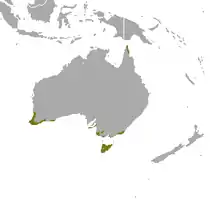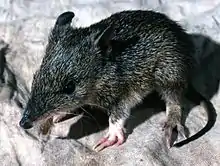Southern brown bandicoot
The southern brown bandicoot (Isoodon obesulus) is a short-nosed bandicoot, a type of marsupial, found mostly in southern Australia. A similar species in South Western Australia, known as the quenda (from the Noongar word 'kwinda')[3] was previously thought to be the southern brown bandicoot, but has since been identified as a separate animal and reclassified as Isoodon fusciventer.[4]
| Southern brown bandicoot[1] | |
|---|---|
_2%252C_Vic%252C_jjron%252C_09.01.2013.jpg.webp) | |
| Foraging adult | |
| Scientific classification | |
| Kingdom: | Animalia |
| Phylum: | Chordata |
| Class: | Mammalia |
| Infraclass: | Marsupialia |
| Order: | Peramelemorphia |
| Family: | Peramelidae |
| Genus: | Isoodon |
| Species: | I. obesulus |
| Binomial name | |
| Isoodon obesulus (Shaw, 1797) | |
| Subspecies | |
| |
 | |
| Southern brown bandicoot range | |
Taxonomy
George Shaw described the species as Didelphis obesula in 1797. While some authorities list as many as five subspecies (I. o. fusciventer, I. o. obesulus, I. o. peninsulae, I. o. affinus, I. o. nauticus), the most recent edition of "Mammal Species of the World" only lists I. o. nauticus as a valid subspecies, aside from the nominate; the others are given synonym status.[1]
Description
_(6008902402).jpg.webp)
Southern brown bandicoots have a stocky body with a short snout and short, rounded ears. They show sexual dimorphism, with females being smaller than males. On average, males measure 50 cm (20 in) in total length, and weigh up to 1.2 kg (2.6 lb), while females measure 40 cm (16 in) and weigh no more than 1 kg (2.2 lb). They have coarse, bristly hair that is grizzled and coloured a dark greyish to yellowish brown, with the undersides a creamy-white or yellowish grey. The tail is relatively short, measuring about 13 cm (5.1 in) in length, and is brown above and white below.[3][5]
There are five toes on each foot, although, as in many other marsupials, the second and third toes of the hind foot are fused along almost their entire length. The toes end in sturdy claws, except for the first digits of the fore feet and the fifth digits of the hind feet, which are tiny are vestigial. The pouch in females opens to the rear, and contains eight teats arranged in a partial circle.[5]

Distribution and habitat
Once common throughout many parts of coastal Australia, today southern brown bandicoots have a more limited distribution. An isolated population exists at the north-eastern part of the Cape York Peninsula in Queensland, but all other surviving animals are found in the southern half of the country. In New South Wales they are considered rare, and are primarily restricted to the extreme south-east of the state and to two national parks north of Sydney. In Victoria, they are more common, being found along the whole length of the coast and at up to 1,000 m (3,300 ft) in the Grampian and Dandenong mountains.[5]
In South Australia, they inhabit the Eyre and Fleurieu peninsulas, the extreme southeast, and Kangaroo Island.[6] However, southern brown bandicoots are most common in Tasmania, where they are found across almost the entire island. They are also currently found on Inner Sister Island but have been extirpated from many other small Tasmanian islands where they once lived.[5]
Within these regions, southern brown bandicoots inhabit open forest, scrub, and heathland, especially where there is extensive ground cover by shrubs or mat-rushes.[5][7] Two subspecies are currently recognised:
- Isoodon obesulus nauticus - restricted to the Nuyts Archipelago
- Isoodon obesulus obesulus - all other localities
Biology and behaviour
Southern brown bandicoots are nocturnal and omnivorous, feeding on insects, spiders, worms, plant roots, ferns, and fungi.[7] They spend very little time drinking, being able to obtain sufficient water from their diet alone.[8] Although their native predators include barn owls, tiger snakes, and quolls, the bandicoots do not avoid the odour of these animals, which may make them vulnerable to predation.[9] They do, however, typically avoid one another, living solitary lives in non-overlapping home ranges that typically vary from 1 to 5 hectares (2.5 to 12.4 acres), depending on the local conditions. If males encounter one another, the more dominant individual leaps onto the back of the other, scratching with its claws. Because the skin of bandicoots is unusually thick, this results in hair loss, but little permanent injury to the defeated male.[5]
They spend much of the night searching for food, which the detect primarily by scent, sniffing the ground before digging into with their claws. They pursue any prey that escapes, holding it down with their forepaws as they consume it. They spend the day sleeping in well-concealed nests of shredded vegetation.[5] Both sexes possess scent glands between the ears that are apparently used in intra-species communication and become enlarged during the breeding season.[10]
The Southern brown bandicoot is a host of the Acanthocephalan intestinal parasite Australiformis semoni.[11]
Life history
Reproduction is closely linked to local rainfall pattern, and many brown bandicoots breed all year around, giving birth to up to four litters a year.[12] Gestation lasts less than fifteen days, and perhaps as few as twelve, and typically results in the birth of two or three young, although litters of up to five have been reported;[5] larger mothers tend to give birth to larger litters.[13]
The young weigh just 350 mg (5.4 gr) at birth, remain in the pouch for about the first 53 days of life, and are fully weaned at around 60 days. Growth and maturation is relatively rapid among marsupials, with females becoming sexually mature at four to five months of age, and males at six or seven months. Lifespan in the wild is probably no more than four years.[5]
Conservation status
The southern brown bandicoot is currently classified as Least Concern by the IUCN.[14] However, populations have declined markedly and become much more fragmented in the time since European expansion on the Australian mainland. In many areas of its range the species is threatened locally, while it may be common where rainfall is high enough and vegetation cover is thick enough. Apart from habitat fragmentation, the species is under pressure from introduced predators such as the red fox and feral cats.[14] It has been reintroduced to some lower rainfall areas where there is protection against cat and fox predation – one such site being Wadderin Sanctuary in the eastern wheatbelt of Western Australia, 300 km east of Perth.
In national assessment, the southern brown bandicoot is currently regarded as Endangered on the mainland as a whole, and Vulnerable in South Australia.[15]
References
| Wikimedia Commons has media related to Isoodon obesulus. |
- Groves, C.P. (2005). "Order Peramelemorphia". In Wilson, D.E.; Reeder, D.M (eds.). Mammal Species of the World: A Taxonomic and Geographic Reference (3rd ed.). Johns Hopkins University Press. p. 39. ISBN 978-0-8018-8221-0. OCLC 62265494.
- "Isoodon obesulus obesulus — Southern Brown Bandicoot (eastern), Southern Brown Bandicoot (south-eastern)". Species Profile and Threats Database. Australian Government, Department of Agriculture, Water and the Environment. Retrieved 2020-07-29.
- "Quenda" (PDF). Archived from the original (PDF) on 2007-09-20. Retrieved 2007-07-23.
- "Quenda QandA – WWF-Australia". www.wwf.org.au. Retrieved 2020-12-24.
- Dressen, M.M. & Rose, R.K. (December 2015). "Isoodon obesulus (Peramelemorphia: Peramelidae)". Mammalian Species. 47 (929): 112–123. doi:10.1093/mspecies/sev012.CS1 maint: uses authors parameter (link)
- Paull, D. (1995). "The distribution of the southern brown bandicoot (Isoodon obesulus obesulus) in South Australia". Wildlife Research. 22 (5): 585–599. doi:10.1071/WR9950585.CS1 maint: uses authors parameter (link)
- Keiper, P. & Johnson, C.N. (June 2004). "Diet and habitat preference of the Cape York short-nosed bandicoot (Isoodon obesulus peninsulae) in north-east Queensland". Wildlife Research. 31 (3): 259–265. doi:10.1071/WR02030.CS1 maint: uses authors parameter (link)
- Larcombe, A.N. (2003). "Activity rhythms of southern brown bandicoots Isoodon obesulus (Marsupialia: Peramelidae) in captivity". Australian Mammalogy. 25 (1): 81–86. doi:10.1071/AM03081.CS1 maint: uses authors parameter (link)
- Mella, V.S.A., Cooper, C.E., & Davies, S.J.J.F. (December 2010). "Predator odour does not influence trappability of southern brown bandicoots (Isoodon obesulus) and common brushtail possums (Trichosurus vulpecula)". Evolutionary, Molecular and Comparative Zoology. 58 (5): 267–272. doi:10.1071/ZO10049.CS1 maint: uses authors parameter (link)
- Stoddard, D.M. (1980). "Observations on the structure and function of cephalic skin glands in bandicoots (Marsupialia: Peramelidae)". Australian Journal of Zoology. 28 (1): 33–41. doi:10.1071/ZO9800033.CS1 maint: uses authors parameter (link)
- Schmidt, Gerald D.; Edmonds, Stanley J. (1989). "Australiformis semoni (Linstow, 1898) n. Gen., n. Comb. (Acanthocephala: Moniliformidae) from Marsupials of Australia and New Guinea". The Journal of Parasitology. 75 (2): 215–7. doi:10.2307/3282769. JSTOR 3282769. PMID 2926590.
- Whitfield, Philip (1998). The Simon & Schuster Encyclopedia of Animals. New York: Marshall Editions Development Limited. p. 24.
- Stoddart, D.M. & Braithwaite, R.W. (1979). "A strategy for utilization of heathland habitat by the brown bandicoot (Isoodon obesulus; Marsupialia, Peramelidae)". Journal of Animal Ecology. 48 (1): 165–179. doi:10.2307/4107. JSTOR 4107.CS1 maint: uses authors parameter (link)
- Friend, T., Morris, K., van Weenen, J., Winter, J. & Menkhorst, P. (2008). "Isoodon obesulus". IUCN Red List of Threatened Species. 2008: e.T40553A10333481. doi:10.2305/IUCN.UK.2008.RLTS.T40553A10333481.en.CS1 maint: uses authors parameter (link)
- "Informing Biodiversity Conservation for the Adelaide and Mount Lofty Ranges Region, South Australia" (PDF). Department for Environment and Heritage, Government of South Australia.
